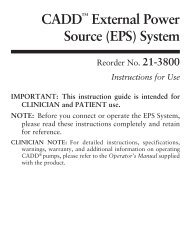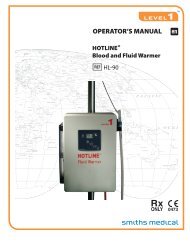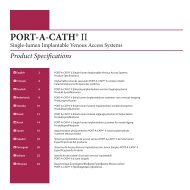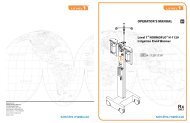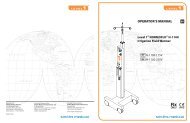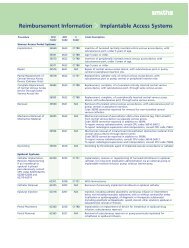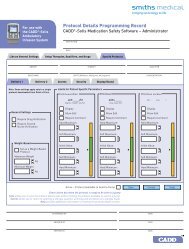EQUATOR® Convective Warmer - Smiths Medical
EQUATOR® Convective Warmer - Smiths Medical
EQUATOR® Convective Warmer - Smiths Medical
Create successful ePaper yourself
Turn your PDF publications into a flip-book with our unique Google optimized e-Paper software.
Attaching the Older Style Sheet Clip<br />
1 Slide the sheet clip lock (h) away from the jaws-like opening.<br />
2 Insert the sheet into the open jaws (i) and slide the sheet clip lock<br />
towards the opening until it clicks and locks in place.<br />
Note: Proper attachment of the sheet clip to the sheet under the<br />
patient is essential to the proper function of the sheet clip assembly.<br />
The weight of the patient on the sheet helps hold the hose in place<br />
when the sheet clip is used.<br />
Step 6: Using the <strong>Convective</strong> <strong>Warmer</strong><br />
CONTRAINDICATIONS<br />
S E C T I O N 6 • O p e r a t i n g I n s t r u c t i o n s<br />
• Thermal injury may occur if convective warming therapy is applied to lower extremities during<br />
aortic cross-clamping procedures.<br />
• Thermal injury may occur if convective warming therapy is applied to ischemic limbs.<br />
WARNINGS WARNINGS<br />
• Grounding reliability can only be achieved when the MAINS power cord is connected to a<br />
properly grounded receptacle. Risk of electrical shock exists if the equipment is not connected<br />
to a properly grounded receptacle resulting in death or serious injury to the patient or user.<br />
• Exposed conductor on the MAINS power cord can cause an electrocution hazard. Remove the<br />
device from service if the MAINS power cord has exposed wires.<br />
• Do not operate the <strong>Convective</strong> <strong>Warmer</strong> in the presence of a flammable anesthetic mixture<br />
with air, oxygen, or nitrous oxide. The risk of explosion exists if the device is operated in a<br />
potentially explosive environment.<br />
• Always start therapy on the lowest non-ambient temperature setting to prevent thermal<br />
injury. Increase the temperature setting, if required, using core body temperature and<br />
cutaneous response of skin in contact with the convective warming blanket as indicators.<br />
• To prevent thermal injury, do not use the highest temperature setting when treating patients<br />
who have decreased sensation, are nonsensate, or have poor perfusion.<br />
• Monitor patient's body core temperature, vital signs, and observe cutaneous response at<br />
regular intervals to prevent thermal injury. If erythema or instability in vital signs is evident,<br />
decrease the temperature setting or discontinue use of convective warming therapy.<br />
continued<br />
EQUATOR ® <strong>Convective</strong> <strong>Warmer</strong> | Operator’s Manual 17<br />
h<br />
i



